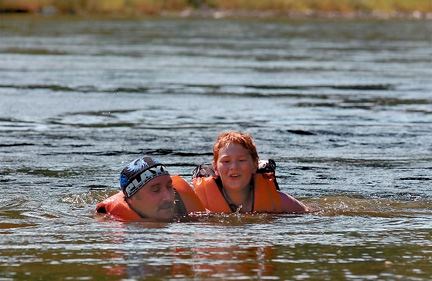Jumping into the river may be a tempting way to get out of the heat - and escape the mosquitoes - but if you do, the physics that come with moving water may well work against you unless you know what you're doing.
Prince George Fire Rescue captain Larry Obst referred to a rule of thumb when it comes to fast-flowing rivers: "If you double the speed, you quadruple the force."
That can especially come home on the Fraser which usually runs faster than the Nechako.
Like electricity, the water will go to where the flow is easiest and carry the swimmer along with it.
"And that's usually where the current is going to be the fastest and the current will always be the fastest farthest away from the edge, farthest from the bottom and just under the surface," Obst said.
Swimmers typically get into trouble when they get tired from fighting the current and slip underneath the surface. There is some technique in swimming in a river, "but that takes some education," Obst said.
Adding to the hazard, even on a warm day the water is still colder than a person's core temperature and can quickly lead to hypothermia. The limbs used to keep afloat become weaker as the body restricts blood flow to the outer region to keep the central area warm.
"If it was 20 degrees outside and you were to just stand around without moving, your core temperature would drop at a certain rate," Obst said. "When you're in the water, it'll drop 25 times faster."
What's more, if the swimmer gets stuck against a log or an abutment and can't move, the core temperature will drop 250 times faster reducing the ability to self-rescue or swim.
"Even when it's hot out, there's always the potential of becoming hypothermic," Obst said. "That's why, even on a hot day, it's essential for the rescuers to be dressed up in the appropriate equipment.
"We may end up being stationary while dealing with something and we have to be protected against becoming hypothermic and losing our ability to function ourselves."
Even when the river's level is relatively low and its flow is not so fast there are still hazards to consider, a major one being a so-called "foot entrapment" where a person's foot gets stuck between some rocks or under a tree and can't get freed.
One way to prevent that is to keep your feet up. "Don't try and walk until you can touch the bottom with your hands," Obst said.
If you're on the shore and see someone in trouble, try to throw out anything that floats - a soccer ball, a football, a Styrofoam cooler, even an empty two-litre pop bottle with the lid done up.
"To give them a little bit of an edge, if they can just hang onto something that floats, they don't need to worry about getting to shore right away," Obst said. "Just try to avoid getting pinned on something...it's really critical just to avoid it."
Fifteen-year-old William Quail, last seen a week ago going under while swimming with a friend in the Fraser near the Hudson's Bay Wetland Nature Park (formerly the Hudson's Bay Slough), remains missing.



.png;w=120;h=80;mode=crop)